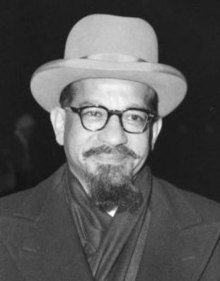Moises Frumencio da Costa Gomez
 From Wikipedia the free encyclopedia
From Wikipedia the free encyclopedia
Moises da Costa Gomez | |
|---|---|
 Da Costa Gomez in 1960 | |
| 1st Prime Minister of the Netherlands Antilles | |
| In office 18 April 1951 – 15 December 1954 | |
| Monarch | Juliana |
| Preceded by | Office established |
| Succeeded by | Efraïn Jonckheer |
| Personal details | |
| Born | 27 October 1907 Otrobanda, Curaçao, Curaçao and Dependencies |
| Died | 22 November 1966 (aged 59) Willemstad, Curaçao, Netherlands Antilles |
| Political party | National People's Party |
| Spouse | Lucina da Costa Gomez |
Moises Frumencio da Costa Gomez (27 October 1907 – 22 November 1966) was the president of the first Governing Council of the Netherlands Antilles and the first Prime Minister of the Netherlands Antilles.[1][2][3]
Biography
[edit]Da Costa Gomez was born on 27 October 1907 in Curaçao. At the age of 15, he was given a scholarship to the Netherlands. In 1932, he graduated his law studies at the Radboud University Nijmegen. In 1935, he received his doctorate at the University of Amsterdam.[4]: 194
Da Costa Gomez was, like John Horris Sprockel, a member of the Roman Catholic Party. He founded the National People's Party in the 1940s.[5] Da Costa Gomez was president of the first Governing Council (Regeringsraad) at the head of a coalition government with the Aruban People's Party (AVP) from 1951 to 1954,[4]: 196 and is often referred to as the first Prime Minister of the Netherlands Antilles.[6][7]
His party negotiated full autonomy at the 1954 Roundtable Conference, involving the Netherlands and Suriname.[8] Following the 1954 elections, the Democratic Party took over governing the Netherlands Antilles.[5] Da Costa Gomez remained the leader of the National People's Party; he was succeeded in leadership by Juan Evertsz after his death in 1966.[5]
Da Costa Gomez's doctoral thesis called for self-government and universal suffrage and inspired his followers as well as the Roman Catholic Party.[8] Reforms led by Gomez led to legalization of tambú music parties in 1952.[9] In 1973 a statue of the statesman was unveiled in the center of the Curaçao capital Willemstad.[2]
He is buried in a monument at the Morada Santa in Bottelier.[10]
References
[edit]- ^ "Amigoe di Curacao : weekblad voor de Curacaosche eilanden". www.delpher.nl (in Dutch). 22 November 1966. Retrieved 29 September 2018.
- ^ a b Caribbean monthly bulletin: Volumes 7-9, 1973
- ^ "Staatkundige geschiedenis periode 1". www.nationaalarchief.cw. Retrieved 2 October 2018.
- ^ a b Gert Oostindie; Emy Maduro (1986). "In het land der overheerser II" (PDF). Verhandelingen van het Koninklijk Instituut voor Taal-, Land- en Volkenkunde (in Dutch). 100. Dordrecht: Foris Publications.
- ^ a b c Anderson, William A; Russell R Dynes (1975). Social movements, violence, and change: The May Movement in Curaçao. Columbus, OH: Ohio State University Press. pp. 50–52. ISBN 0-8142-0240-3.
- ^ "Lezing over Mr. Dr. Moises Frumencio Da Costa Gomez". Werkgroep Caraibische Letteren (in Dutch). Retrieved 23 January 2022.
- ^ "Vandaag 55 jaar geleden overleed Doktor". Curacao.nu (in Dutch). 22 November 2021. Retrieved 23 January 2022.
- ^ a b Modern political culture in the Caribbean by Holger Henke, Fred Reńo, page 386
- ^ The 'air of liberty': narratives of the South Atlantic past by Ineke Phaf-Rheinberger, page 124
- ^ "Morada Santa - Bottelier". Curacao Cemetery. Retrieved 23 January 2022.
